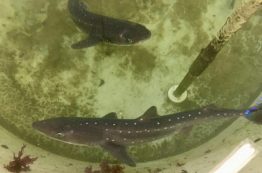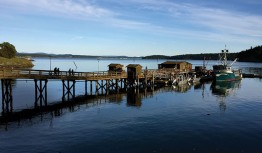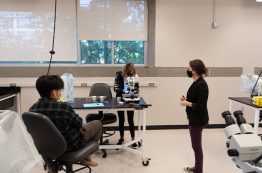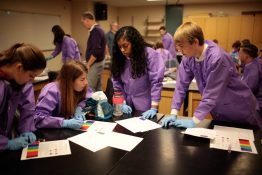Contrary to what popular media portrays, we actually don’t know much about what sharks eat. Even less is known about how they digest their food, and the role they play in the larger ocean ecosystem. For more than a century, researchers have relied on flat sketches of sharks’ digestive systems to discern how they function — and how what they eat and excrete impacts other species in the ocean.
Read more at UW News »Thousands of baby sea stars born at UW lab are sign of hope for endangered species
Just a few days shy of the first day of spring, scientists at Friday Harbor Laboratories on San Juan Island had reason to celebrate. Dozens of juvenile sea stars, no bigger than a poppy seed, had successfully metamorphosed from floating larvae to mini star — the important first step toward becoming an adult. Between now and then, these sunflower sea stars, the largest sea star species in the world, will grow up to 24 arms and a colorful body the size of a serving platter.
Read more at UW News »An oasis for scholars: the Helen Riaboff Whiteley Center
Sailing into Friday Harbor, you can’t miss the set of long, low-slung buildings along the water’s northern edge. They are home to the famed Friday Harbor Laboratories (FHL), a research outpost housed within the larger University of Washington College of the Environment. The labs have operated over one hundred years, first gaining notoriety for their impact in evolutionary and neuroscience. Over the decades, the labs have added marine ecology, seawater chemistry, biomechanics and all flavors of oceanography to their research repertoire.
Read more »Active learning during the COVID-19 pandemic
After news that summer, fall and eventually winter quarters are mostly to be conducted virtually, many instructors within the College of the Environment found themselves forced to write new lesson plans, while also becoming proficient with an array of new technology quickly. Not only did they have to teach, but in many cases they also had to be a tech wizard to facilitate remote lab work and deliver engaging lectures over a computer screen.
Read more »Diversity, equity and inclusion at UW Environment
The tragic events of spring quarter have emphasized the tremendous amount of work that still needs to be done to counteract the mistreatment and marginalization of Black, Indigenous and people of color (BIPoC) and create an environment that is more just, more equitable and more inclusive. Schools, programs, institutes and departments within the College of the Environment have been working hard to refine, rethink and deepen their work in the Diversity, Equity and Inclusion (DEI) space, often led by unit-level diversity committees.
Read more »





